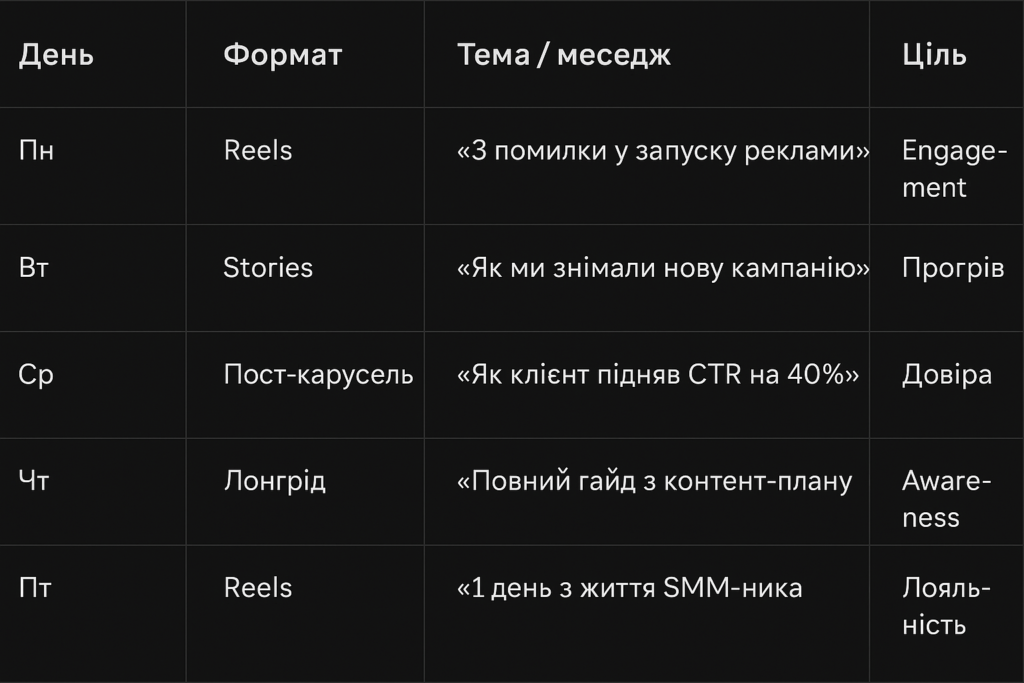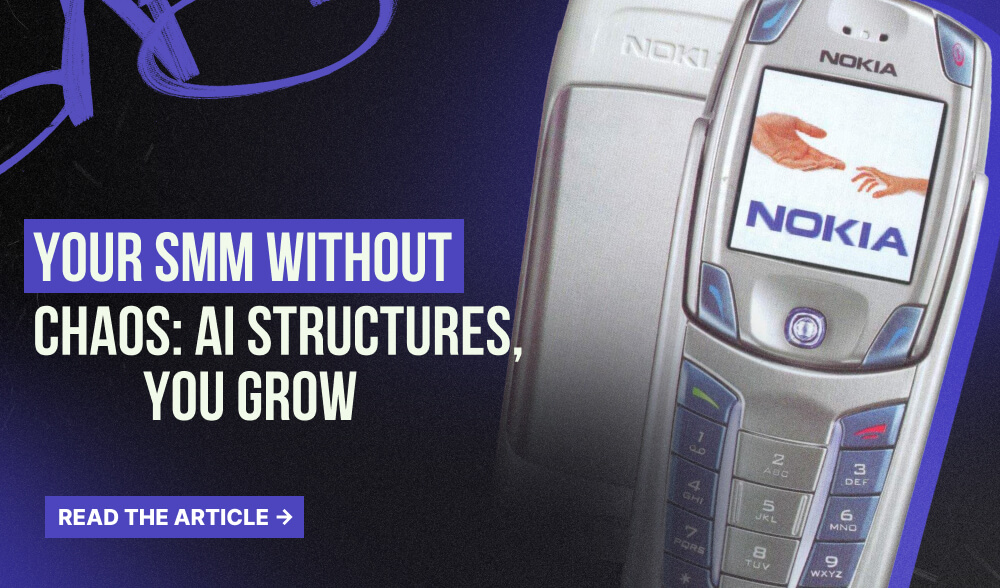Artificial intelligence in SMM is no longer a fantasy. It doesn’t replace humans, but becomes a partner who never burns out, remembers every detail, and instantly throws up fresh ideas. Its power is not in magic, but in consistency: formulate the task correctly, and instead of chaotic notes, you will get a content plan template that covers the entire process from strategy and rubrication to formats, calendar, and analytics.

Content plan: the luminary around which all the activities of an email marketing campaign revolve
In short, SMM does not work without a content plan. It doesn’t “work badly” or “barely hold on”, but it doesn’t work. Even the coolest ideas are lost, posts are haphazard, and communication breaks down into a chaotic stream of incompatible messages: one-time memes, random news, or posts “for show.”
Instead, a clear content plan gathers disparate elements into a coherent system, highlights holes in the content grid, and tells you where to go next. Each publication becomes a part of the big picture, headings work as clear strategy blocks, and content days are built not “by feel” but for business goals. And that’s where AI comes in. Not to take away your role as a marketer or strategist, but to take all the routine off your shoulders: techniques like Ctrl+C/Ctrl+V, systematization, and small fiddling so you can focus on scale.
Strategic level: how to create a content plan that not only exists, but works
The lack of a clear strategy turns a content plan into a regular calendar with ideas. You can post, share stories, and spin reels every day, but without a set vector, all this will remain invisible among thousands of other publications. Therefore, before creating a content plan, you need to analyze the basis: why we create this content and where we lead the audience.
This is where the strategic level of work with AI begins – when you don’t generate ideas at random, but give the system a clear vector on which to build the structure:

Audience and competitors under the AI microscope
Previously, strategic research meant a bunch of signs, endless Google queries, and scrolling competitors until you fainted, but now AI allows you to dig deeper and faster. Here you will get not dry numbers like “18-24, women, cities with a population of over a million,” but audience segmentation by pains, desires, triggers, and behavioral patterns.
Competitive analysis is also moving to a new level: artificial intelligence scrolls through feeds instead of you, collects an array of data, and gives you what used to take hours to do. It extracts the topics and formats of competitors’ posts, records the frequency of publications, picks up their tone of voice, reads key communication channels, highlights the strengths of the strategy, and highlights white spots.
All this analytics gives you a clear understanding of what a content plan looks like. It’s not an abstract list of ideas, but a strategic map with key themes, headings, formats, and a communication funnel. Neurons that can really come in handy:
Strategic SMM content plan: the skeleton
When the strategy is already defined and the analytics are worked out, it’s time to move on to the next stage – building a skeleton that will later form the basis of the entire content plan. AI takes care of the routine part of this process. You just need to formulate the right promo in ChatGPT or Claude, and you have a balanced content architecture with clear topic pillars, headings, and formats.
The base is ready – it’s time to breathe life into it. With Notion AI, Coda, or ClickUp, you just need to enter the topic pillars and headings into a table, and the AI will instantly organize everything into calendars, tags, formats, content types, and channels. Jasper AI is ideal for quickly gathering the basics, for example, to launch a content plan for Instagram. It’s a tool that allows you to easily get started and test several areas without deep dives.
Content plan example: basic structure
After the strategic stages, the question naturally arises: “What does it look like in practice?” AI is not a magic wand, but with a properly formulated query, it produces a clear content plan template in seconds, where the strategy turns into specifics: formats, headings, messages, scheduled by day. Then it’s a matter of technique: correcting the spelling, adjusting the tone of voice, and really promoting the topics. This is not a final document, but a solid foundation that is gradually being polished into a full-fledged plan ready to work for the brand.

There are more tools that can instantly generate a content plan than it seems. Ocoya – you set the brand style, topic, and frequency, and in a moment you get a ready-made content plan for Instagram. ContentStudio has its own AI scheduler that schedules content on a calendar, turning it into a well-oiled machine.
Simplified is any free content plan template and generation for your brand when you need to start beautifully and without unnecessary hassle. And Predis.ai is generally proactive: it produces full-fledged plans with ideas, creatives, and signatures
Topics and headings: intelligent content fuel
No more exhausting brainstorming sessions and coffee marathons. AI swallows niche queries, target audience pains, and trends, and spits out ready-made topics faster than you can open Google Docs. And then it’s all about structure.
Artificial intelligence helps not just to recall a few titles, but to build a logic of rubrication, where each type of content has its own function: one teaches, another warms up, the third entertains or sells. To do this, you can turn to the proven ChatGPT or take a ready-made content plan from Jasper AI. Perplexity AI digs deep into niche queries and trends, providing insights that are difficult to find manually. And Copy.ai, Writesonic, and Rytr work as an idea booster – they quickly sketch out dozens of raw options that you just need to finalize.
And, of course, nowhere without accuracy. AI analyzes the niche, trends, and audience requests to select not just “trendy” hashtags, but those that really push content up in the algorithms. SEO giants like Semrush and Ahrefs add strategic depth by showing the frequency, competition, and potential of each query.
One idea = many formats
AI takes your message and promotes it as a real content pipeline: Reels, Stories, longreads, emails – one idea starts to live on all platforms. A content plan for Instagram automatically becomes a half-finished material for TikTok, blog, or newsletter, without endless rewriting from scratch. The most flexible tools for this are ChatGPT and Claude. They’re a matter of minutes:

Content plan without production is a dead table
You can have impeccably written out topics, a calendar, headings, and even a strategic funnel, but without the production stage, it all remains just a beautiful tableau. Without drafts, scripts, descriptions, and adaptations, the content stays in the “planned” status and never gets published.
In ChatGPT or Claude, you can get drafts of posts in the right tone of voice in a matter of minutes, write scripts for Reels with hook phrases and clear timings, and come up with dozens of variations of headlines and CTAs. And then connect Notion AI or ClickUp to automatically schedule everything on the calendar and turn a dry content plan for Instagram or TikTok into a live content stream.
Bringing it all together: a content plan as a system
When you have your ideas in hand, it’s time to turn them into a clear content plan. This is where the routine part begins, which AI does almost flawlessly. Instead of marathoning through calendars and manually dragging and dropping topics, neurons get to work: they automatically categorize posts by content type, optimize the frequency of posts for each platform and audience behavior.
For example, in Notion AI or ClickUp AI, you can simply insert topic pillars and headings into a table, and the system will organize everything by calendar, tags, content types, and channels. And if you want to automate timings, feel free to use Buffer, Later, or Metricool, which automatically suggest the best time slots to capture maximum engagement.
Smart after the launch: how AI keeps your SMM content plan in shape
When the posts have already gone live, the fun begins: the strategy no longer lives on paper and starts to respond to real data and audience behavior. AI swoops in like an analyst on steroids: it instantly reads engagement rate, CTR, reach, comments, and tracks the dynamics of posts. Based on this, it suggests adjustments to the content plan, tells you where to strengthen sections or change the format, and where to keep the pace.
A.I. is not limited to dry statistics: it catches trends before they even start, reads hidden patterns of reach growth, and tells you exactly where to shift your focus in the next content cycle. Tables and calendars are no longer frozen – they live, updating automatically, turning the plan into a flexible system.

A content plan is not a static file forgotten in Google Docs, but a living mechanism that develops along with the brand. Today, it’s enough to set a clear vector, and AI picks up the rest, working as an invisible strategist and executor at the same time. It is not limited to generating topics, but permeates the entire cycle: from building a strategy and structure to adapting formats, production, analytics, and continuous improvement after launch.


